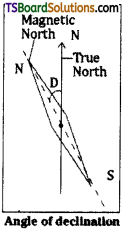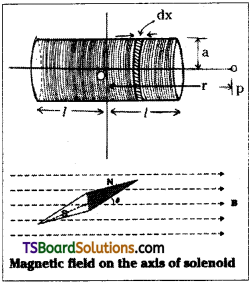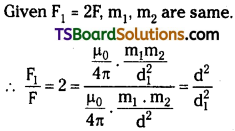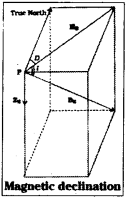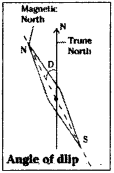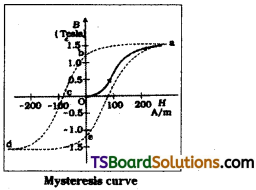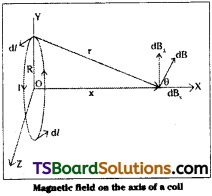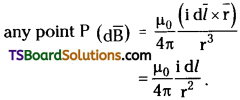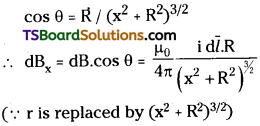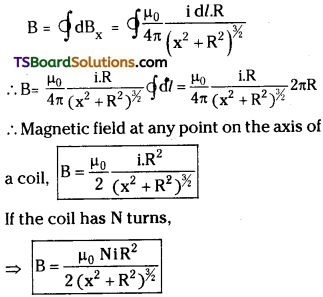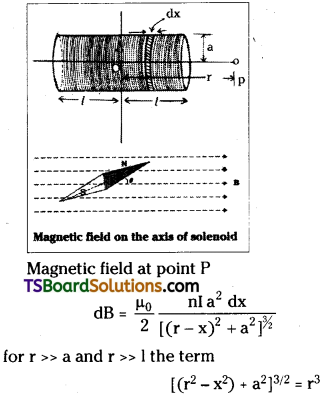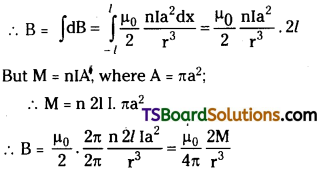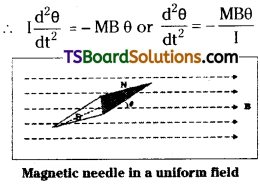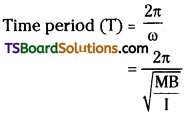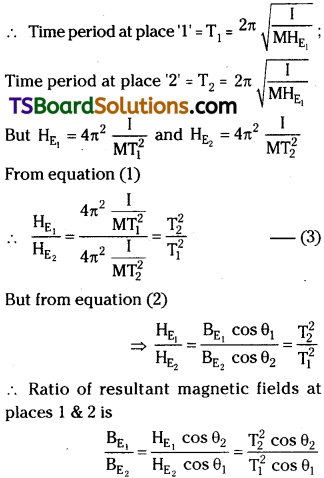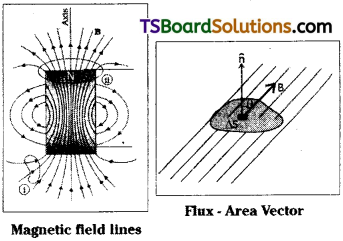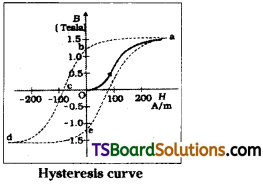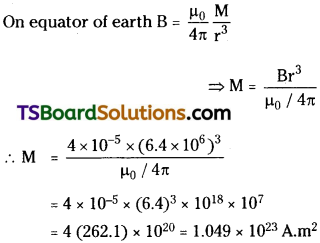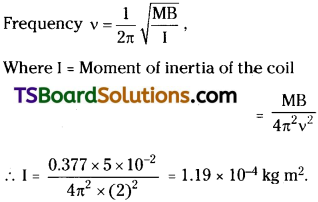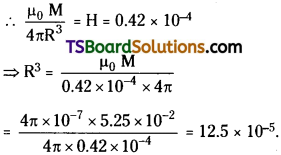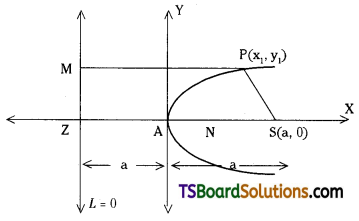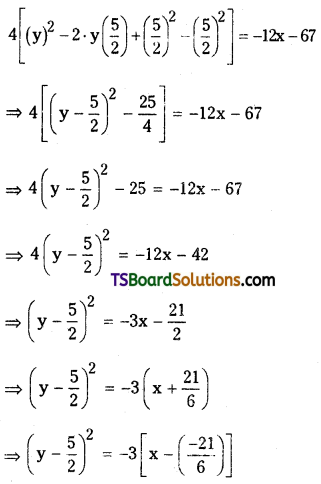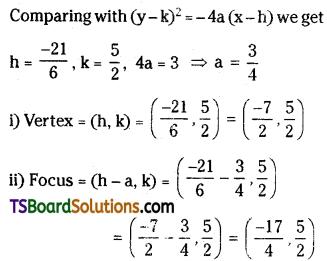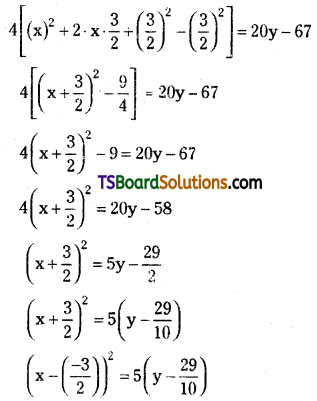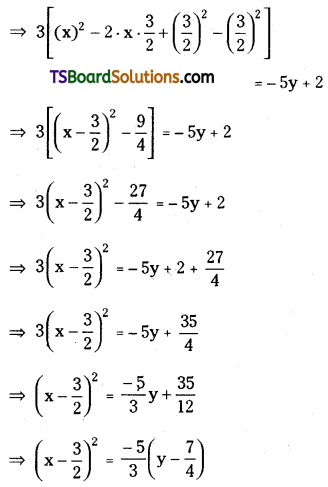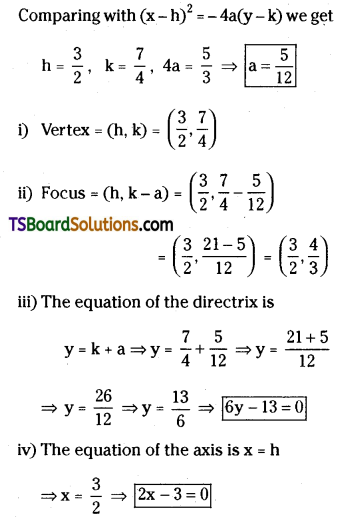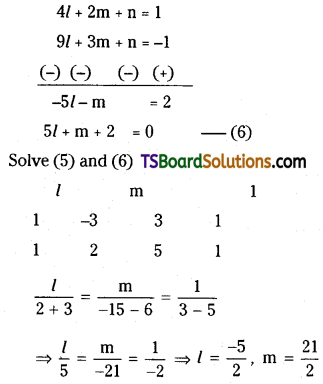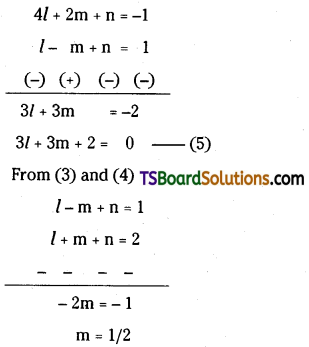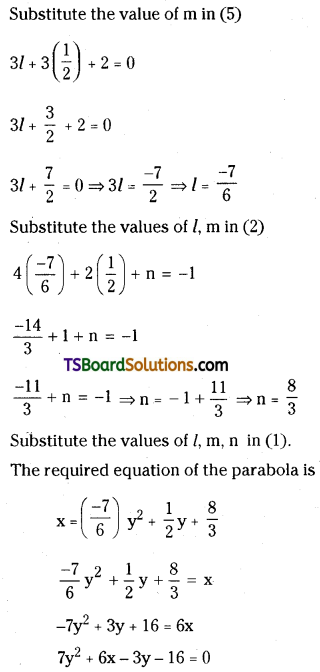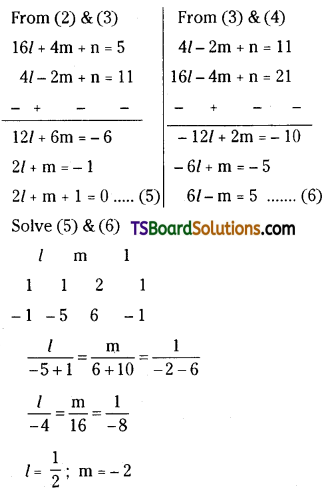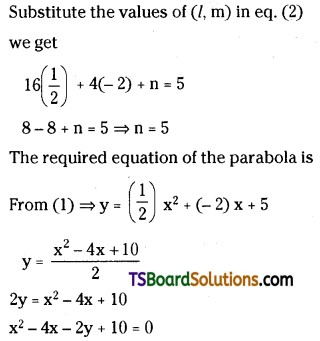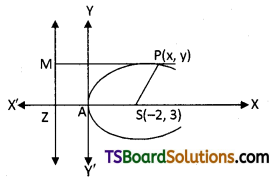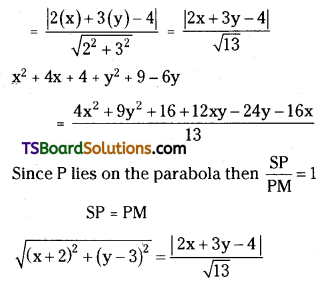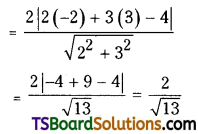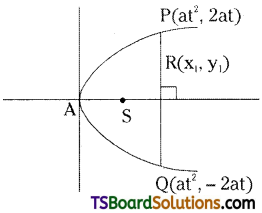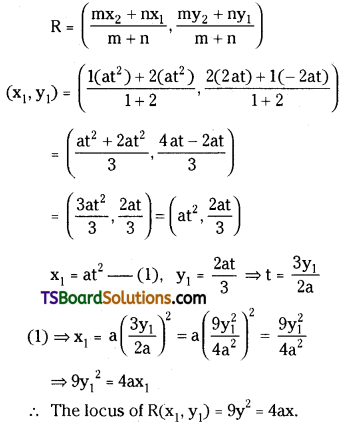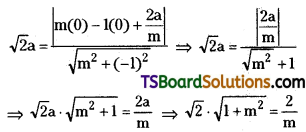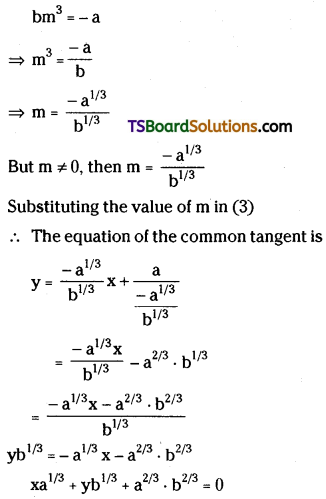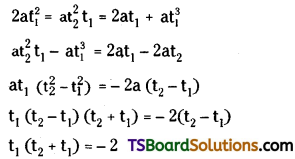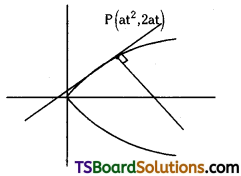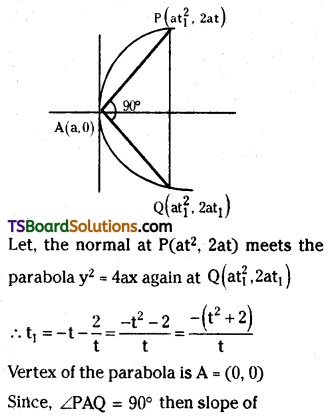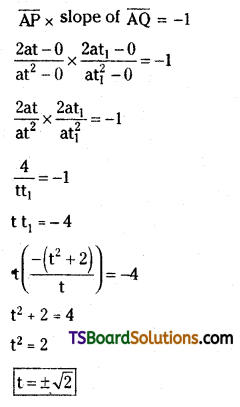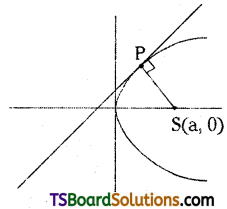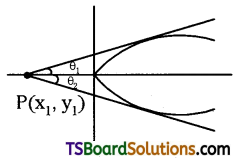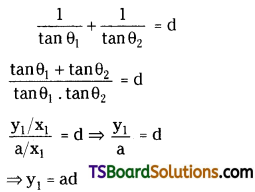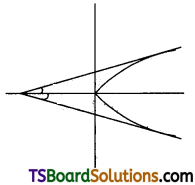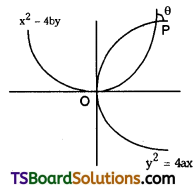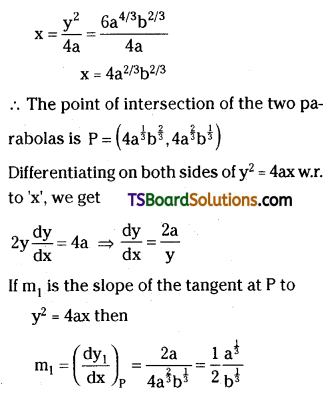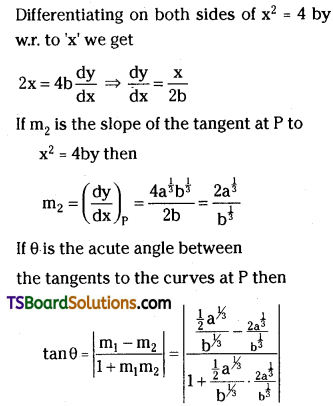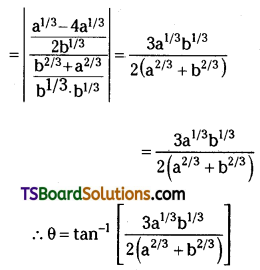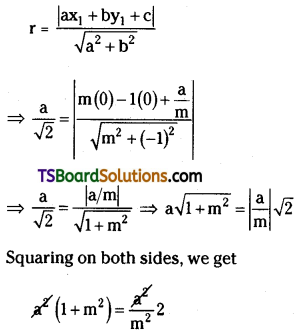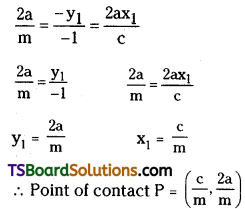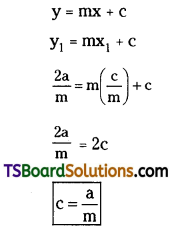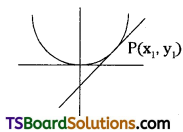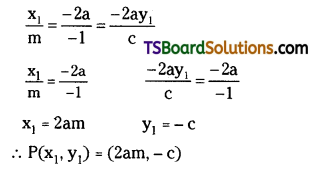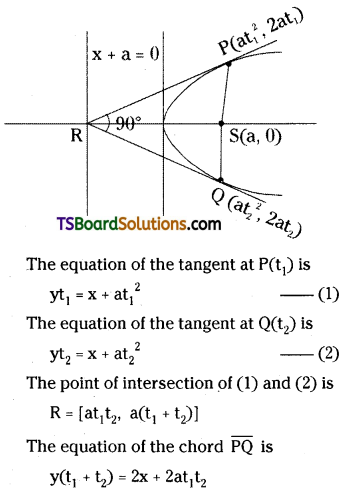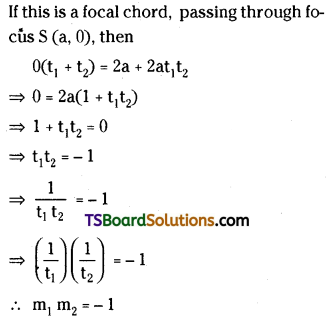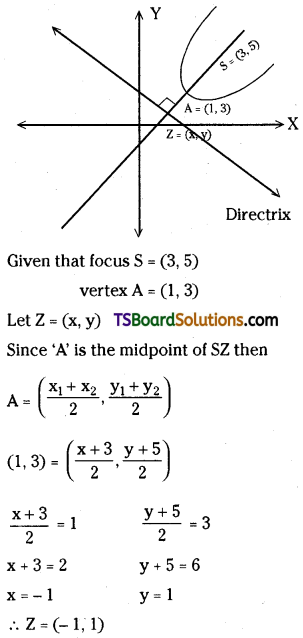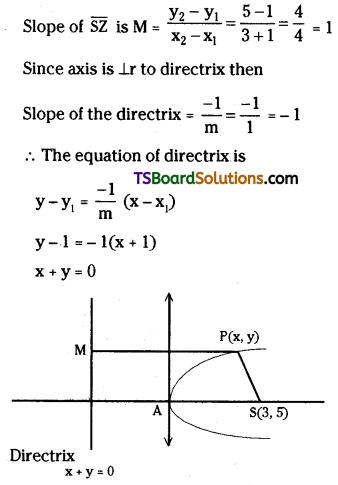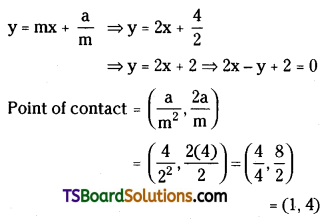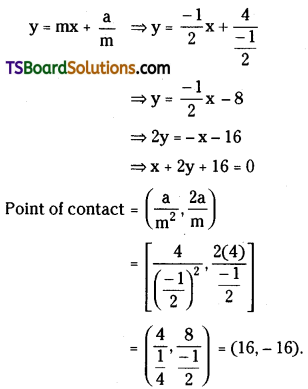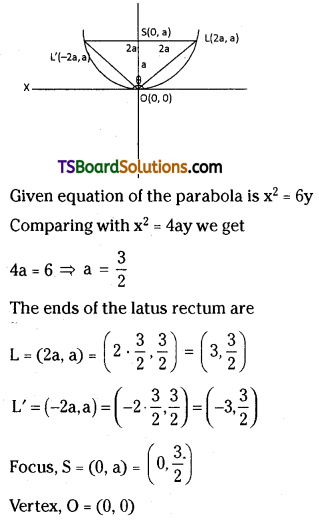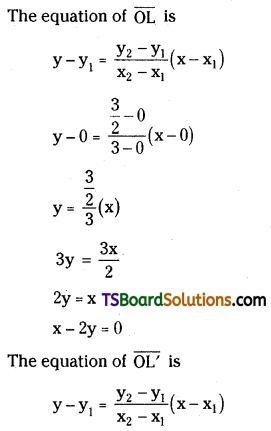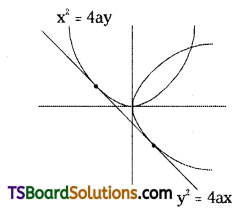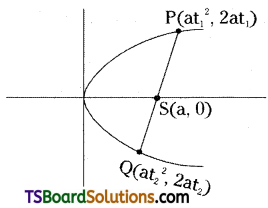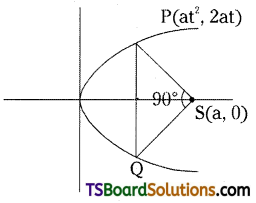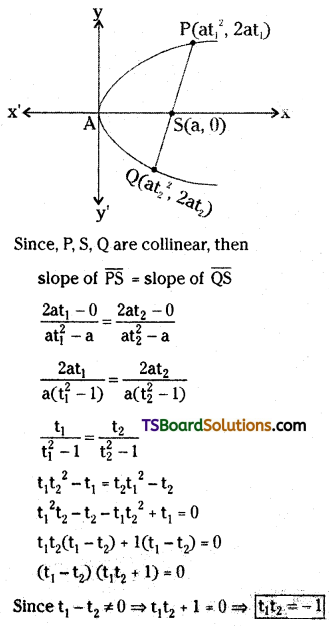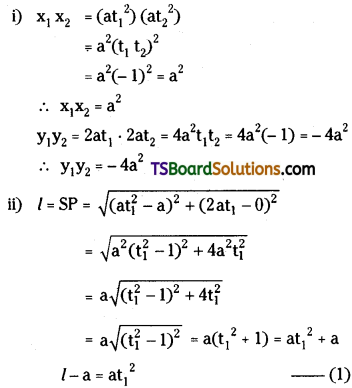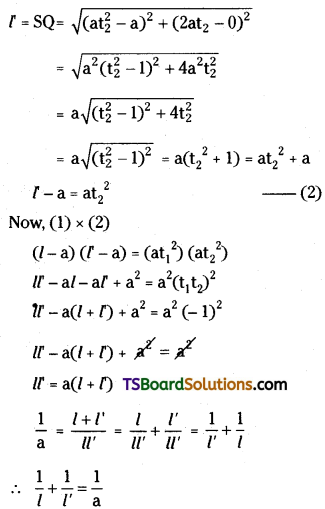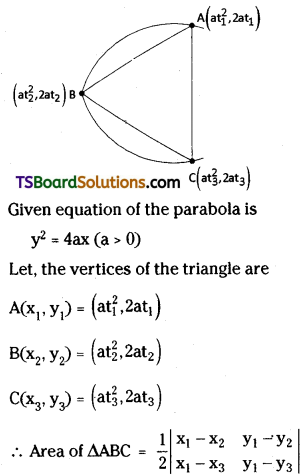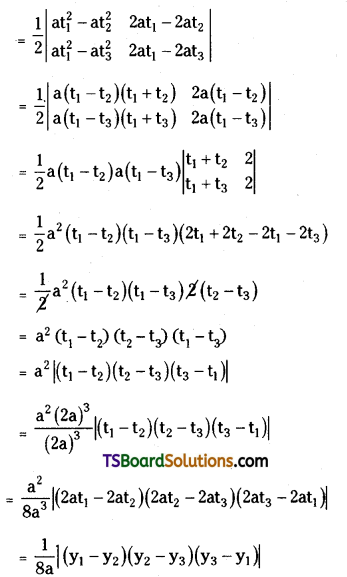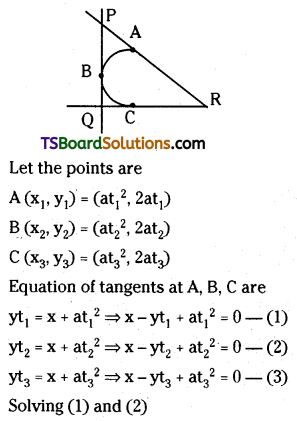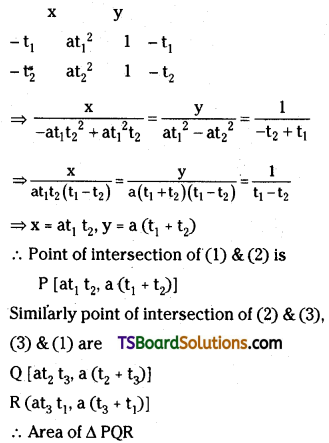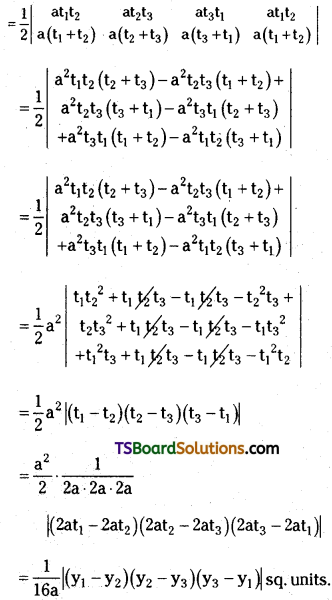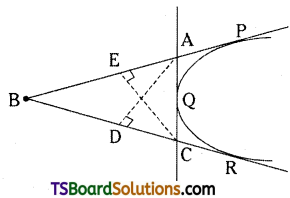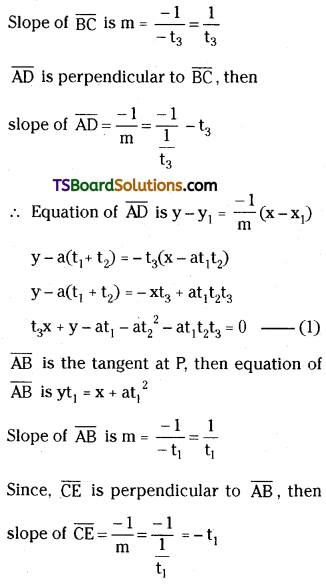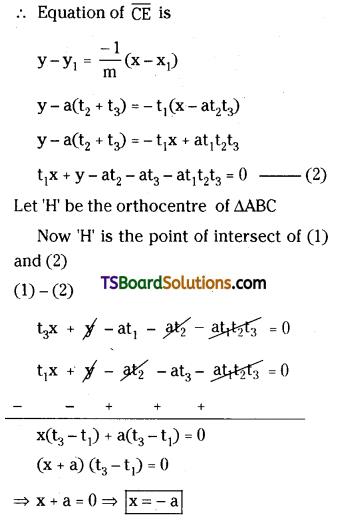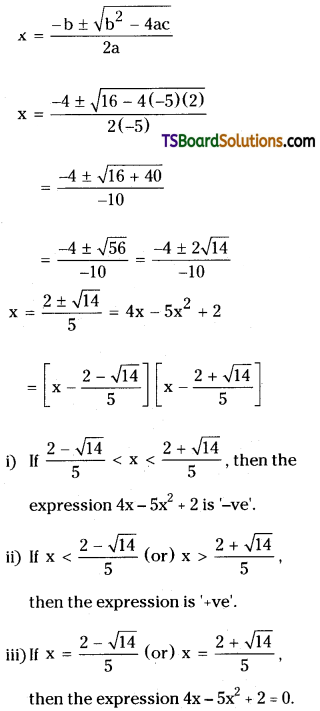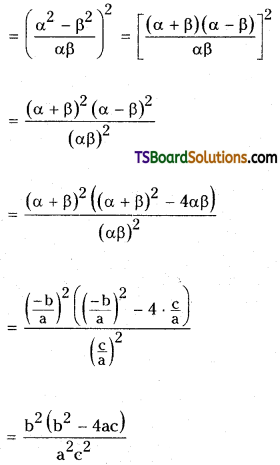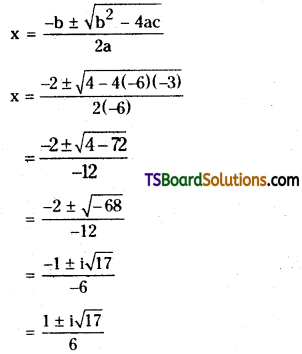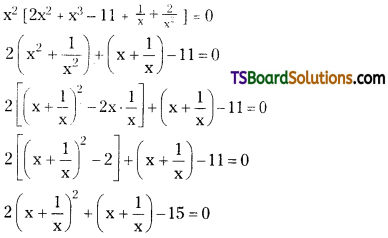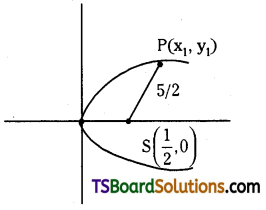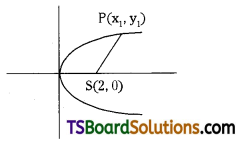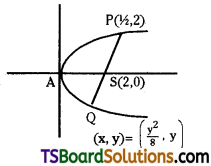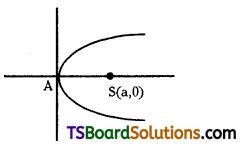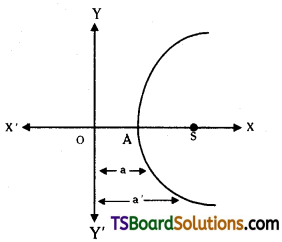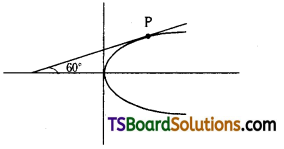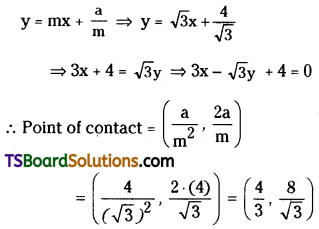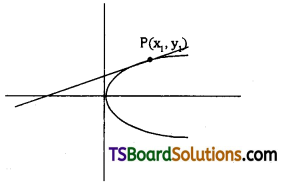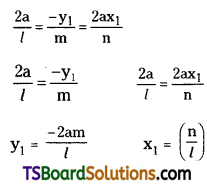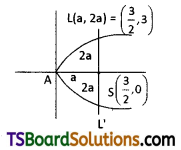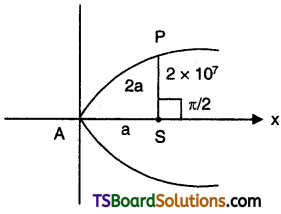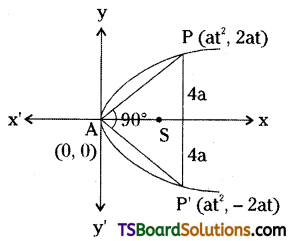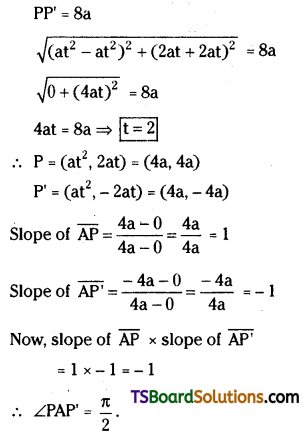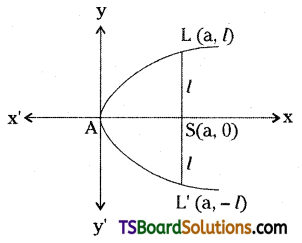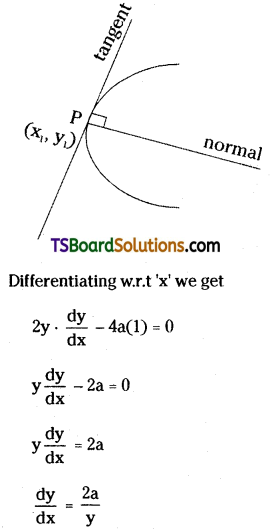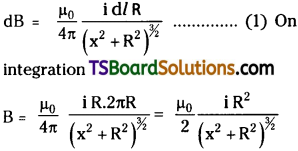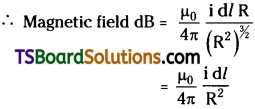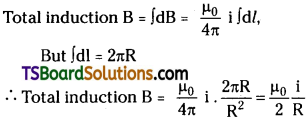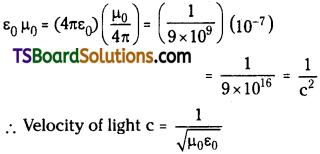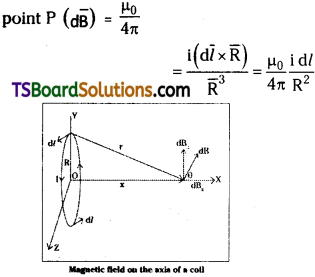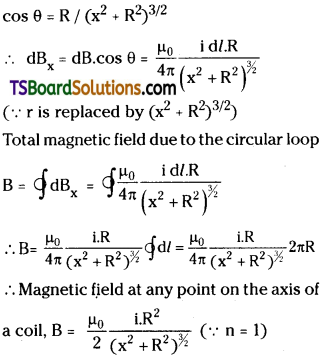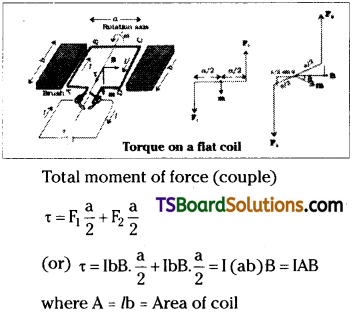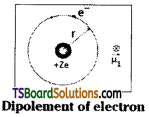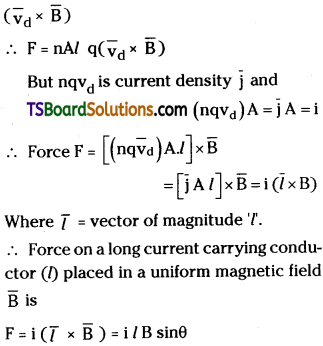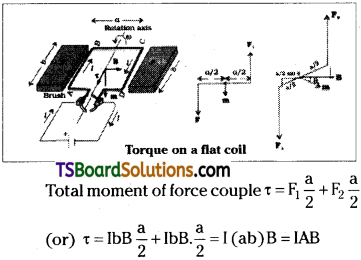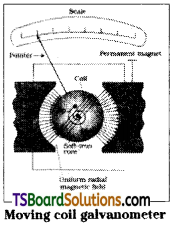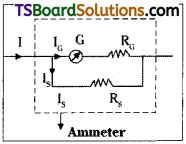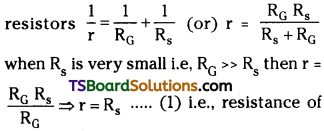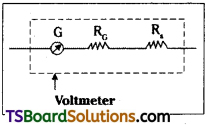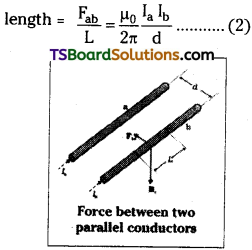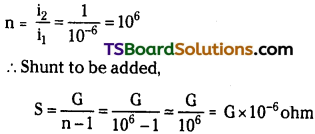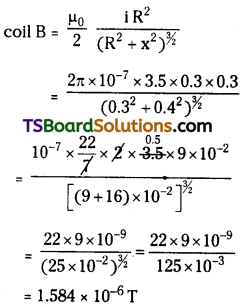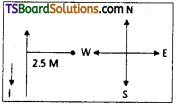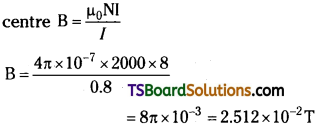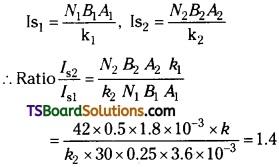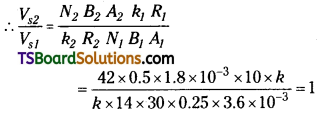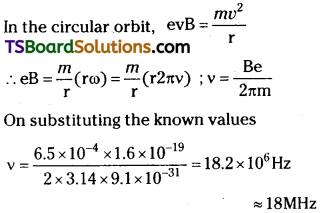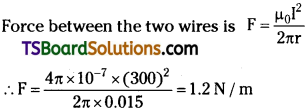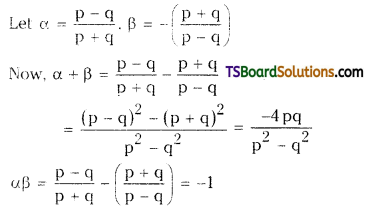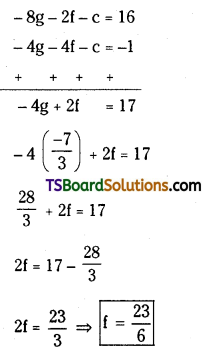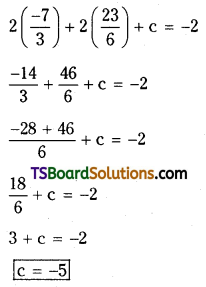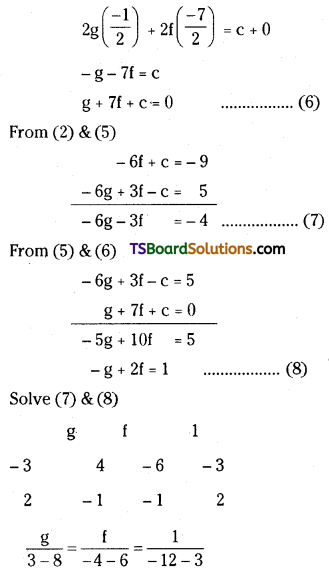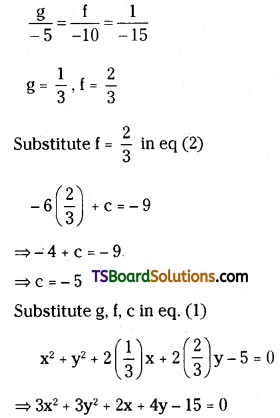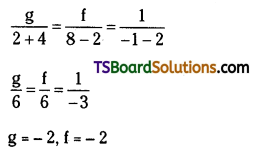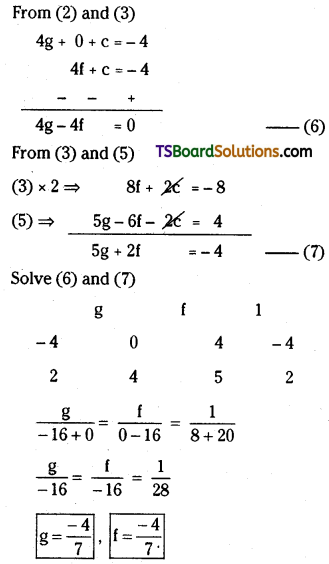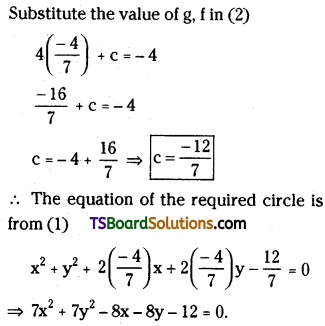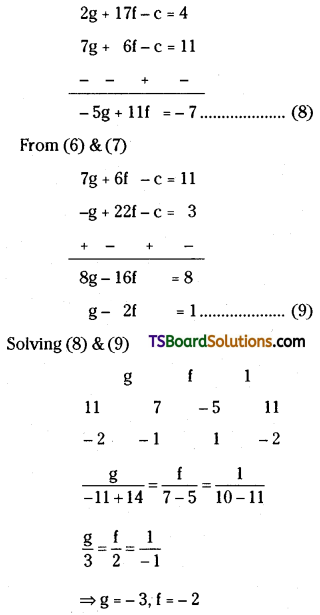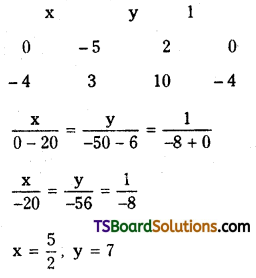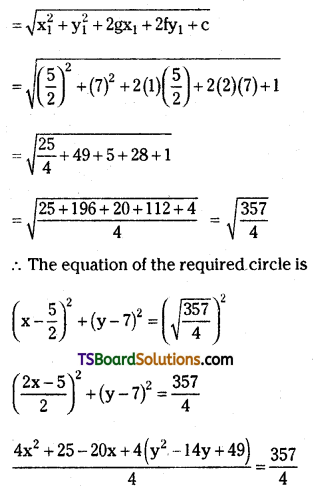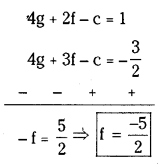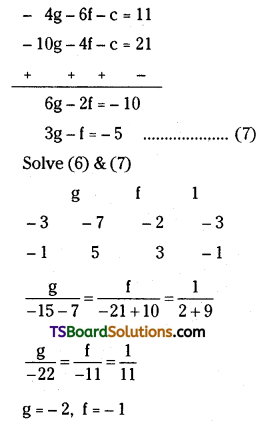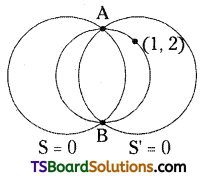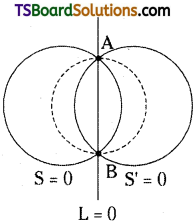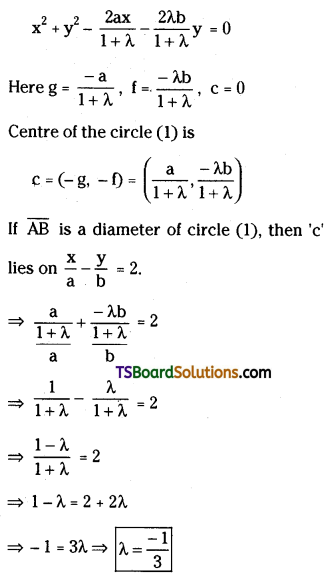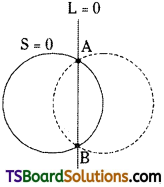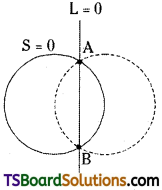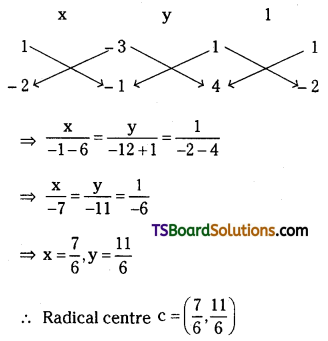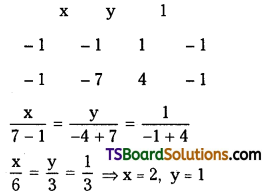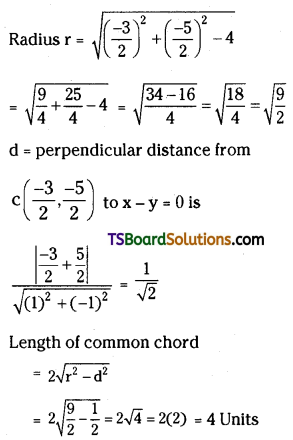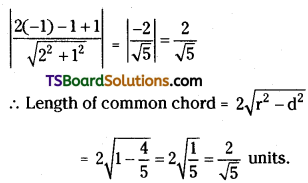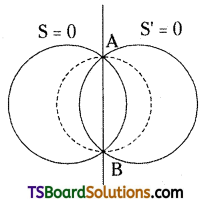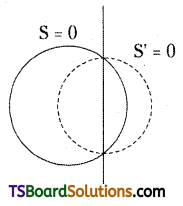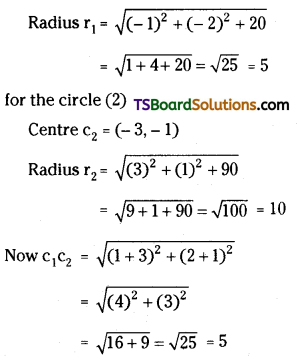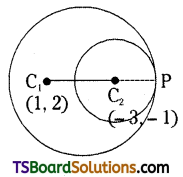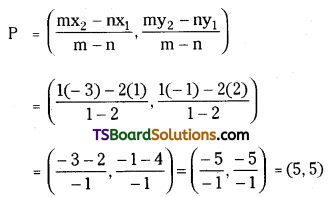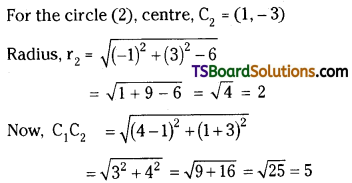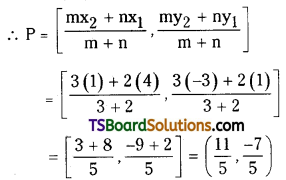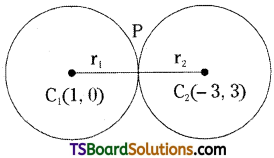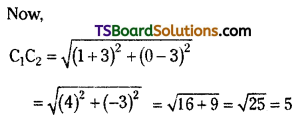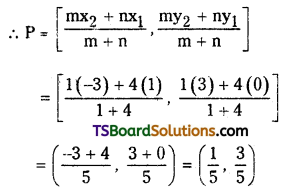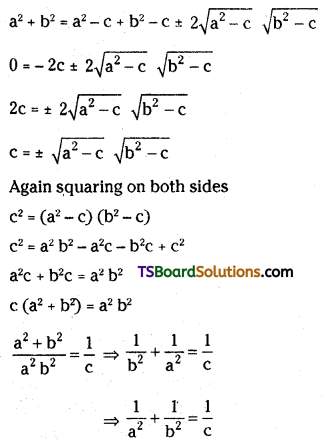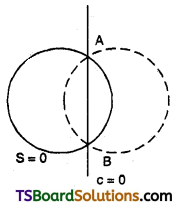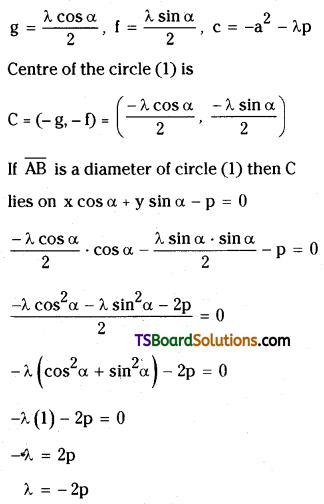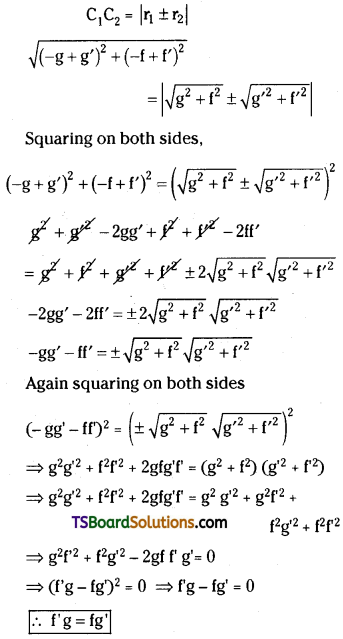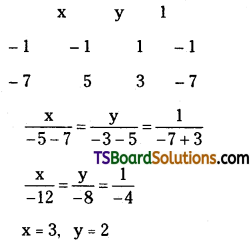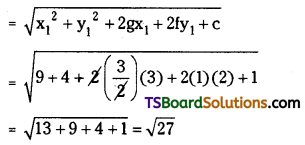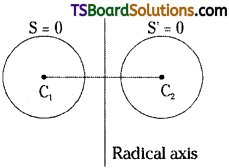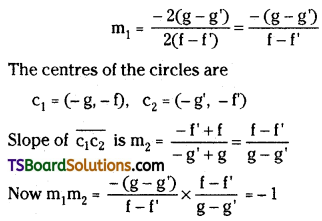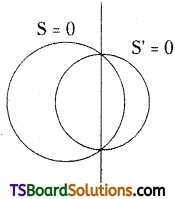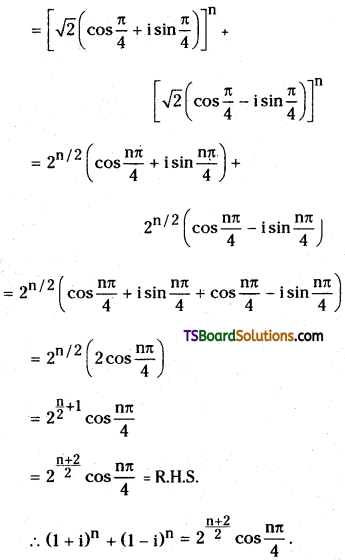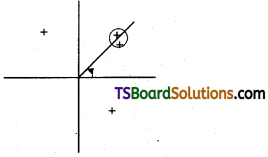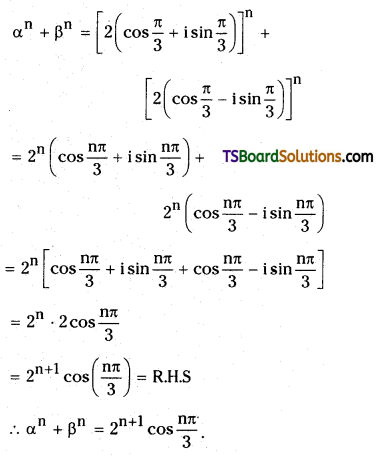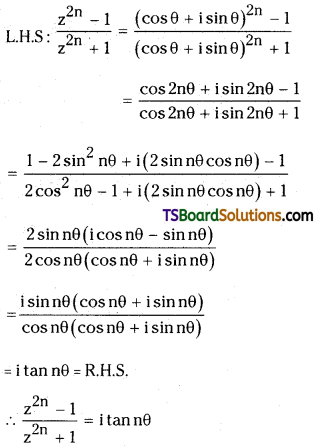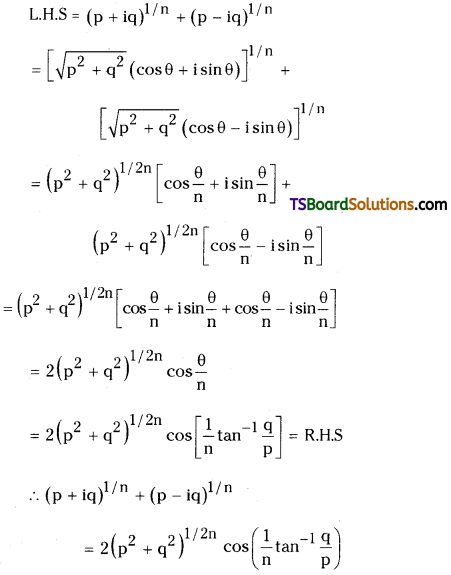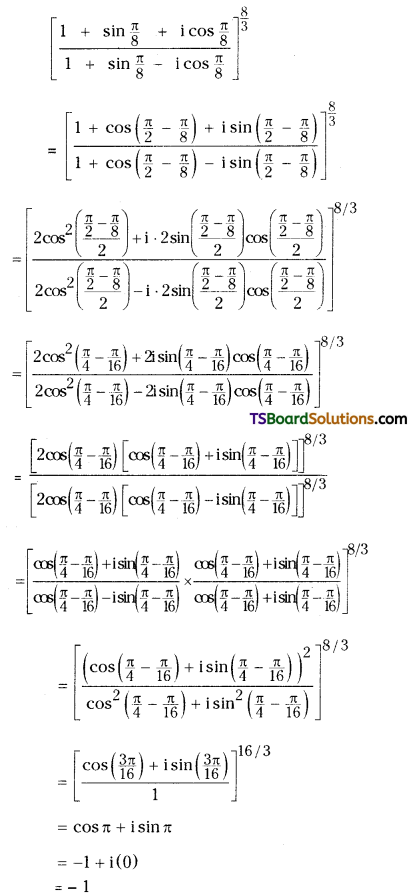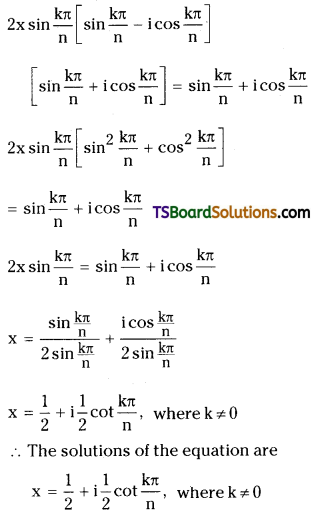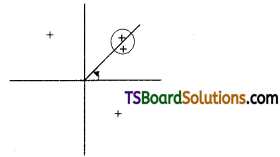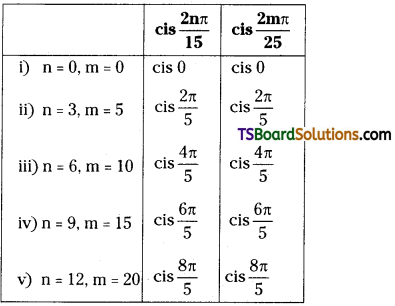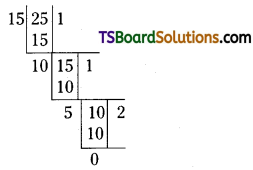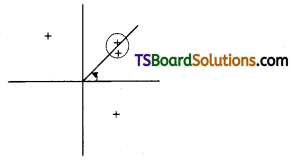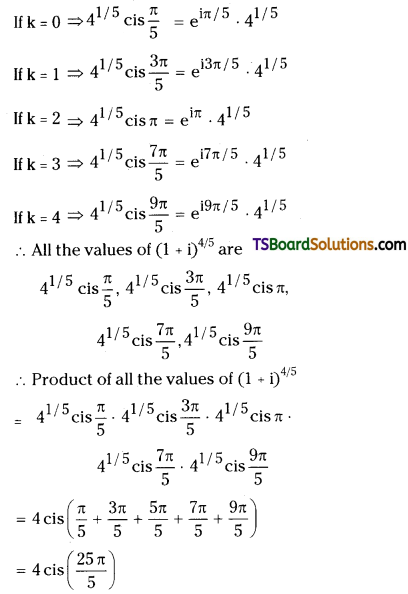Telangana TSBIE TS Inter 2nd Year Physics Study Material 6th Lesson Current Electricity Textbook Questions and Answers.
TS Inter 2nd Year Physics Study Material 6th Lesson Current Electricity
Very Short Answer Type Questions
Question 1.
Define mean free path of electron in a conductor.
Answer:
Mean free path :
It is defined as the average distance that an electron can travel between two successive collisions.
Question 2.
State Ohm’s law and write its mathematical form.
Answer:
Ohm’s law :
At constant temperature current (I) flowing through a conductor is proportional to the potential difference between the ends of that conductor.
V ∝ I ⇒ V = RI where R = constant called resistance. Unit: Ohm (Ω).
Question 3.
Define resistivity (or) specific resistance.
Answer:
Resistivity :
Resistivity of a substance ρ = \(\frac{RA}{l}\)
It is defined as the resistance of a unit cube between its opposite parallel surfaces.
It depends on the nature of substance but not on its dimensions.
Unit: Ohm – metre (Ωm).
Question 4.
Define temperature coefficient of resistance.
Answer:
Temperature coefficient of resistivity :
The resistivity of a substance changes with temperature. ρτ = ρ0 [1 + ∝ (T – T0)]. Where a is temperature coefficient of resistivity.
Question 5.
Under what conditions is the current through the mixed grouping of cells maximum?
(Note: Mixed grouping of cells not given in New Syllabus.)
Answer:
Let m cells are in series and there are n such rows this arrangement is called mixed grouping.
In mixed grouping current (i) = \(\frac{mnE}{mr + nR}\)
Current will be maximum when mr = nR
∴ imax = \(\frac{nE}{2r}\)

Question 6.
If a wire is stretched to double its original length without loss of mass, how will the resistivity of the wire be influenced?
Answer:
Resistivity (ρ) is independent of dimensions of the material. It depends only on nature of material.
So even though the wire is stretched its resistivity does not change.
Question 7.
Why is manganin used for making standard resistors?
Answer:
Temperature coefficient of resistance of manganin is very less. So its resistance is almost constant over a wide range of temperature.
Due to this reason manganin is used to prepare standard resistances.
Question 8.
The sequence of bands marked on a carbon resistor are : Red, Red, Red, Silver. What is its resistance and tolerance?
Answer:
Given sequence of colour band Red Red Red Silver
Colour code for Red = 2
1st band red = 2 ; ‘
2nd band Red = 2
3rd band = No. of zeros = 2 (∵ Red) :
∴ Resistance R = 2200 Ω
tolerance band (4th band) Silver = 10%
∴ For silver resistor R = 2200 Ω with 10% tolerance.
Question 9.
Write the colour code of a carbon resistor of resistance 23 kilo ohms.
Answer:
Reistance 23 kilo ohms = 23000
∴ 1st band = 2 ⇒ Red ;
2nd band = 3 ⇒ orange
3rd band = No. of zeroes = 3 ⇒ orange
∴ Colour code for 23 kΩ = Red Orange, Orange.
Question 10.
If the voltage V applied across a conductor is increased to 2V, how will the drift velocity of the electrons change?
Answer:
Drift velocity will also double.
Drift velocity vd = \(\frac{-p}{m}\)Eτ
Where E = intensity of electric field. It depends on applied potential. When applied potential is doubled (V to 2V). Intensity of electric field E is also doubled.
(∵ E = \(\frac{V}{d}\) , where d is not charged). So drift d velocity is doubled.

Question 11.
Two wires of equal length, of copper and manganin, have the same resistance. Which wire is thicker?
Answer:
Manganin wire is thicker.
Resistance R = ρ\(\frac{l}{A}\) given l is same.
For copper specific resistance ρ is less than manganin.
∵ R is constant material with high ‘ρ’ must have larger area A.
Hence manganin wire is thicker.
Question 12.
What is the magnetic moment associated with a solenoid of ‘N’ turns having radius of cross-section ‘r’ carrying a current I?
Answer:
Magnetic moment of solenoid (N) = πr² In × 2l where ‘2l’ = length of solenoid, r = radius, I = current
n = number of turns.
Question 13.
Why are household appliances connected in parallel?
Answer:
In parallel combination potential drop is constant. Different amounts of current is allowed through each component separately. i.e., we may switch off unwanted connections without disturbing other.
Hence parallel connection of appliances is prefered in household connections.
Question 14.
The electron drift speed in metals is small (~ m-1) and the charge of the electron is also very small (~ 10-19) Q, but we can still obtain a large amount of current in a metal. Why?
Answer:
Eventhough charge of electron ‘e’, drift velocity vd are less number of electrons n is very high, current i = ne vd. (i.e., charges flowing per second)
∵ n is extremely high we are getting large current.
Short Answer Questions
Question 1.
A battery of emf 10 V and internal resistance 3Ω is connected to a resistor R.
(i) If the current in the circuit is 0.5 A. Calculate the value of R.
(ii) What is the terminal voltage of the battery when the circuit is closed? [TS Mar. ’15]
Answer:
emf E = 10V, Internal resistance r = 3Ω
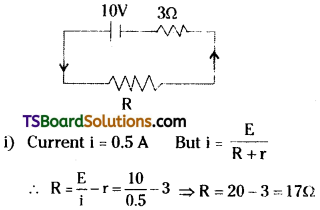
ii) Terminal voltage V = E – ir
∴ V = 10 – 0.5 × 3 = 10 – 1.5 = 8.5V
Question 2.
Draw a circuit diagram showing how a, potentiometer may be used to find internal resistance of a cell and establish a formula for it.
Answer:
Circuit diagram to find internal resistance; of a cell is
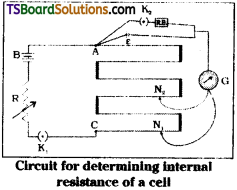
Theory :
i) In circuit key ‘k2’ is open and potentiometer jockey is adjusted to zero deflection.
Balancing length l1 is measured.
Now ε = Φl1 → (1)
ii) Key ‘k2‘ is closed. Balancing length l1 is measured.
Now V = Φl1 → (2)
But ε = I (R + r) and V = IR so from eq (1) & (2)

Question 3.
Derive an expression for the effective resistance when three resistors are connected i) series ii) parallel.
Answer:
i) Series combination :
Let three resistors R1, R2 and R3 be connected in series as shown in figure.

Same current i flows through all resistors.
Potential drop across R1 ⇒ (V1) = iR1
Similarly V2 = iR2 and V3 = iR3 are P.D across R2 + R3
Total potential across AB (V) = V1 + V2 + V3
∴ V = iR1 + iR2 + iR3 = i (R1 + R2 + R3), But V = i R
∴ V = i Req = i(R1 + R2 + R3)
In series combination Req = R1 + R2 + R3
∴ Equivalent resistance is the sum of individual resistors.
ii) Parallel combination of resistors :
Let three resistors R1, R2 and R3 be connected in parallel as shown in figure.
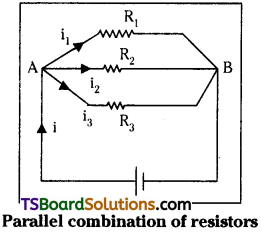
In this combination potential drop across AB is constant. But different values of current flows though each resistor. Total current i = i1 + i2+ i3
Current through R1 ⇒ (i1) = \(\frac{V}{R_1}\) Similarly,
⇒ i2 = \(\frac{V}{R_2}\) and i3 = \(\frac{V}{R_3}\).

Question 4.
‘m’ cells each of emf E and internal resistance ‘r’ are connected in parallel. What is the total emf and internal resistance? Under what conditions is the current drawn from the mixed grouping of cells a maximum?
Answer:
i) Let m’ identical cells each of emf E’ and internal resistance V be connected in parallel as shown in the figure.
ii) Applying Kirchoffs voltage law to the circuit, we have for the first cell,
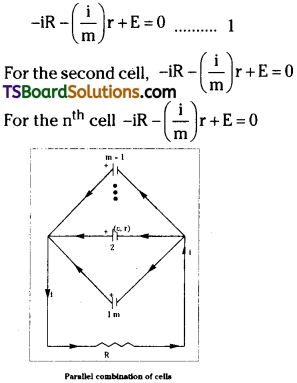
iii) Adding the above m’ equations, we get, – m(iR) – m(\(\frac{i}{m}\))r + mE = 0
(mR + r)i = mE
∴ I = \(\frac{mE}{mR+r}\)
iv) The above expression can be written as
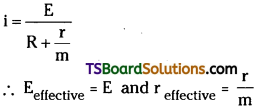
Mixed grouping of cells :
Note : Mixed grouping of cells not given in New Syllabus.
Answer:
Let m cells are in series and there are n such rows this arrangement is called mixed grouping.
In mixed grouping current i = \(\frac{mnE}{mr+nR}\)
Current will be maximum when mr = nR
∴ imax = \(\frac{nE}{2r}\)

Question 5.
Define electric resistance and write it’s SI unit. How does the resistance of a conductor vary if
a) Conductor is stretched to 4 times of it’s length.
b) Temperature of conductor is increased?
Answer:
Resistance :
The obstruction created by a conductor for the mobility of charges through it is known as resistance.
i) The resistance of a conductor (R) is proportional to length R ∝ l → (1)
ii) and inversely proportional to area of cross-section of the conductor.

where “ρ” = resistivity of the conductor.
a) When conductor is stretched by four times its new length l2 = 4l1 or \(\frac{l_1}{l_2}\) = 4
When a wire is stretched by keeping its mass
constant then Rg = R1[latex]\frac{l_2}{l_1}[/latex]²
∴ R2 = R1 . (4)² = 16R1
So when a wire is stretched by 4 time its resistance is increased by 16 times.
b) When temperature of conductor is increased its resistance will increase.
Resistance at t°C is Rt = R0 (1 + αt)
where α’ = temperature coefficient of resistance of that conductor.
Question 6.
When the resistance connected in series with a cell is havled, the current is equal to or slightly less or slightly greater than double. Why?
Answer:
Let a cell of emf ‘E’ and internal resistance ‘r’ is connected with external resistance R as shown in figure.
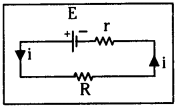
Total resistance in circuit RT = R + r → (1)
Current in circuit i1 = \(\frac{E}{R+r}\) → (2)
a) Now external resistance R is reduced to \(\frac{R}{2}\).
Total resistance in circuit RT1 = \(\frac{R}{2}\) + r
\(\frac{R+2r}{2}\) → (2)
From eq (1) and (3)
\(\frac{R+2r}{2}\) is not equals to \(\frac{R+r}{2}\).
i.e., when R is reduced to \(\frac{R}{2}\) total resistance RT1 is not equals to \(\frac{R_T}{2}\).
So current in the circuit i2 ≠ 2i1. But i2 is slightly less than 2i1 it depends on the value of internal resistance ‘r’.
b) In case of ideal battery where r = 0 then RT2 = \(\frac{R}{2}\) in this case RT2 = \(\frac{R_{T_1}}{2}\)and
current i2 = 2i1.
So when reistance R in the circuit is reduced to half of its value current in circuit is doubled or slightly less than double.
Question 7.
Two cells of emfs 4.5V and 6.0V and internal resistance 6Ω and 3Ω respectively have their negative terminals joined by a wire of 18Ω and positive terminals by a wire of 12Ω resistance. A third resistance wire of 24Ω connects middle points of these wires. Using Kirchhoff s laws, find the potential difference at the ends of this third wire.
Answer:
The circuit diagram as per given data is as shown
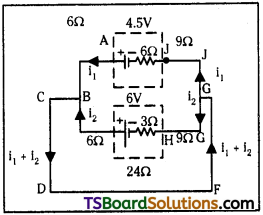
From fig for loop ABCDFGJA
6i1 + 24 (i1 + i2) + 9i1 – 6i1 = 4.5
33i1 + 24i2 = 4.5 → (1)
For loop IBCDFGHI
6i2 + 24(i1 + i2) + 9i2 – 3i2 = 4.5
24i1 + 36i2 = 6.0 → (2)
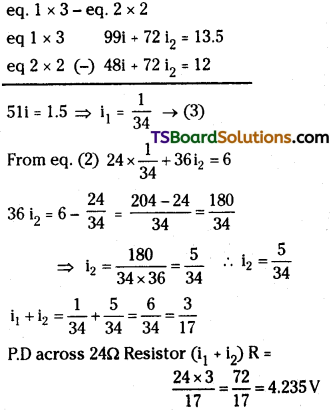
Question 8.
Three resistors each of resistance 10 ohm are connected, in turn, to obtain (i) minimum resistance (ii) maximum resistance. Compute (a) The effective resistance in each case (b) The ratio of minimum to maximum resistance so obtained.
Answer:
Resistance of each resistor R = 10Ω ;
Number of Resistors n = 3
a) In parallel combination resistance is minimum.

b) In series combination resultant resistance is maximum.
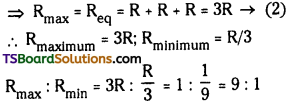
Question 9.
State Kirchhoff s law for an electrical network. Using these laws deduce the condition for balance in a Wheatstone bridge. [AP Mar. ’19. ’18. ’14. May ’16. ’14; TS May ’18. Mar. ’18, ’16, June ’15]
Answer:
Kirchhoffs Laws:
i) Junction rule :
At any junction, the sum of currents towards the junction is equal ‘ to sum of currents away from the junction.
(OR)
Alzebraic sum of currents around a junction is zero.
ii) Loop rule :
Alzebraic sum of changes in potential around any closed loop involving resistors and cells in the loop is zero.
Applying Kirchoff’s Law to Wheatstones bridge:
Wheatstones bridge consists of four resistances P, Q, R, S connected as shown in the figure and are referred as arms of the bridge.
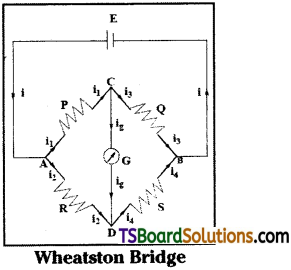
A battery of emf ‘E’ is connected between two junctions A and B and a galvanometer of resistance ‘G’ is connected between ‘C’ and ‘D’.
Applying Kirchoff’s first law,
at the junction C; i1 = ig + i3 — (1)
at the junction D; i2 + ig = i4 — (2)
Applying Kirchoff’s second law for the loop ACDA
– i1 P – ig G + i2 R = 0 — (3)
For the loop CBDC,
– i3 Q + i4 S + ig G = 0 — (4)
If no current passes through the galvanometer then the bridge is said to be balanced.
So, ig = 0, then (1), (2), (3) and (4) becomes
i1 = i3, i2 = i4, i1P = i2R and i3 Q = i4 S.
By adjusting the above equations we get \(\frac{P}{Q}=\frac{R}{S}\).
This is the balancing conditions of a Wheatstones bridge.

Question 10.
State the working principle of potentiometer explain with the help of circuit diagram how the emf of two primary cells are compared by using the potentiometer. [AP Mar. 17,16, May ‘ 17; June ’15; TS Mar. 19, May 16]
Answer:
Potentiometer working principle :
Potentiometer consists of 10 meters length of wire with uniform internal resistance. Let total length of wire is L and its total resistance is Rp.
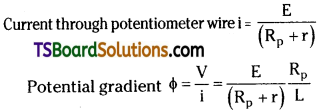
where Φ = Potential drop per unit length i.e., potential gradient.
Comparison of e.m.f. of two cells :
The circuit diagram used to compare emf of two cells is as shown in figure.
Circuit connection were given as per diagram.
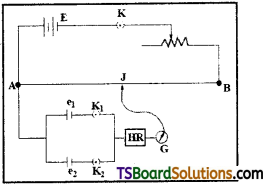
The potentiometer contains two circuits, primary and secondary.
The primary circuit consists of a cell of emf ‘E’ that a plug key (K) and a rheostat (Rh). These are connected in series with potentiometer wire AB.
The secondary circuit consists of two cells of emf e1 and e2, two plug keys K1 and K2, a galvanometer (G) and a Jockey (J) as shown in the figure.
The positive terminals of the two cells in primary and secondary are connected to terminal A’.
Procedure:
i) The plug keys K and K1 are closed and by adjusting Jockey on the wire, the balancing length ‘l1‘ is determined.
e1 ∝ l1 ——- (1)
ii) Now plug key K1 is opened and K2 is closed. Again the Jockey is adjusted and balancing length ‘l2‘ is determined.
e2 ∝ l2 ——- (2)
from (1) and (2 ) \(\frac{e_1}{e_2}=\frac{l_1}{l_2}\) Ratio of emf of two cells.
Question 11.
State the working principle of potentiometer explain with the help of circuit diagram how the potentiometer is used to determine the internal resistance of the given primary cell. I [AP May 18, Mar. 15; TS Mar. 17. 15, May 17]
Answer:
Potentiometer working principle :
Potentiometer consists of 10 meters length of wire with uniform internal resistance. Let total length of wire is L and its total resistance is Rp.
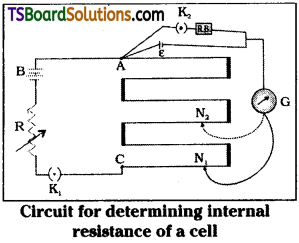
Current through potentiometer wire i
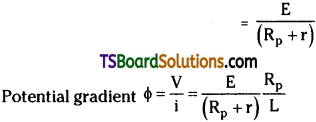
where Φ = Potential drop per unit length i.e., potential gradient.
Determination of internal resistance (r) :
Circuit diagram used to find internal resistance of battery is as shown in figure.
Battery E is connected in primary circuit through plus key k1.
Another battery E1 is connected in secondary circuit. A low resistance R’ is connected in parallel to Battery E1 along with key k2.
Plug k2 is open. Jockey J is moved on potentiometer until zero deflection is obtained. Balancing length l1 is measured.
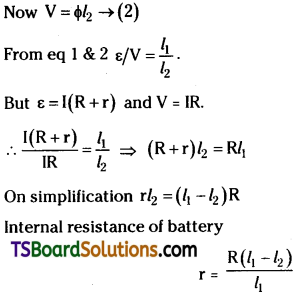
Plug key k2 is closed so resistance R will come into operatioin. Again Jockey J is moved on potentiometer wire to find balancing point. When zero deflection is obtained balancing length l2 is measured.
Question 12.
Show the variation of current versus voltage graph for GaAs and mark the (i) Nonlinear region (ii) Negative resistance region.
Answer:
The voltage-current characteristic graph of galium arsinide (GaAs) is as shown in figure.
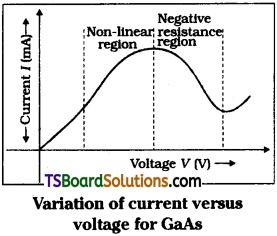
GaAs is a semiconducting substance. Its V-I characteristics are non-ohmic. So V-I graph is not linear.
The region OA is linear. In which Ohm’s Law is obeyed.
The region AB is a curve (i). Here voltage V is not linear with currrent (i). So It is a non-linear region.
(ii) In the region BC current I decreases even though voltage ‘V’ increases.
Resistance R = \(\frac{V}{I}\)
∵ I decreases resistance in the region BC is negative.
The regions (1) and (2) are shown in figure.
Question 13.
A student has two wires of iron and copper of equal length and diameter. He first joins two wires in series and passes an electric current through the combination which increases gradually. After that, he joins two wires in parallel and repeats the process of passing current. Which wire will glow first in each case?
Answer:
Iron and copper wires of equal length and diameter are taken. For Iron, resistivity is ρi high. For copper resistivity, ρc is less.
∴ Resistance of Iron wire Ri is high and Resistance of copper wire Rc is less.
a) When connected in series same current flows through Iron and Copper wires. Heat produced Q = I²R. So heat produced in copper wire is less and that of Iron wire is high.
In series combination when current increases gradually than Iron wire will glow first.
b) When the two wires are connected in parallel and current is increased gradually.
In parallel combination high current flows through low resistance and low current through high resistance. They follow the relation Ic/Ii = Ri/Rc.
So current through copper wire is high. Heat produced Q = i²R ⇒ Qc > Qt
Heat produced in copper wire is more than that in iron wire.
So in parallel combination copper wire will glow first.

Question 14.
Three identical resistors are connected in parallel and total resistance of the circuit is R/3. Find the value of each resistance.
Answer:
In parallel combination when ‘n’ identical wires are connected parallelly equivalent resistance is given by Req = R/n.

Given three identical wires ⇒ n = 3.
∴ Req = R/3 where R is resistance of each wire.
∴ Resistance of each wire used in parallel combination is R.
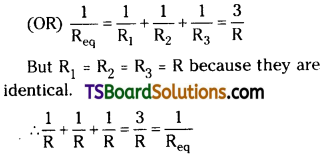
Hence resistance of each wire used in parallel combination is R.
Long Answer Questions
Question 1.
Under what condition is the heat produced in an electric circuit (a) directly pro-portional (b) inversely proportional to the resistance of the circuit? Compute the ratio of the total quantity of heat produced in the two cases.
Answer:
Let a current I is flowing through a conductor between its ends say A and B. Let potential at A is V(A) and potential at B is V(B).
Potential difference across AB is say V = V(A) – V(B)
Let charge flowing in time ∆t is ∆Q = I∆T
Change in potential energy ∆V = Final P.E – Initial P.E
= ∆Q[V(B) – V(A)] = -∆QV = -TV∆t < 0 → (1)
Let charges are moving without collision with atoms.
Then kinetic energy of charges will also increase.
∆K = -∆UPot or ∆K = IV ∆t > 0 → (2)
Work done in this process ∆W = IV ∆t → (3)
But power

From Ohm’s Law V = IR
∴ Power P = I.I.R = I²R
In this case power p ∝ R.
In this case energy of charge carriers is useful to heat the conductor. Amount of energy dissipated in conductor per second is power.
Where priority is given to current through conductor, at ordinary voltages we will say that p ∝ R.
i) In case of transmission lines the primary purpose is to transmit electrical energy from one place to another place. While doing so a part of energy is wasted in conductor in the form of heat. Let total power to be transmitted = P. Resistance of conductor = Rc,
Line voltage = V
Power wasted in transmission or transmission losses Pc = \(\frac{P^2R_c}{V^2}\). Due to this reason to reduce transmission losses we are transmitting electric power at very high voltages.
When voltage is given priority power P = \(\frac{V^2}{R}\)
In this case power P is said to be inversely proportional to resistance ‘R’.
Ratio of heats produced in the two cases is I²R: V²/R
But V = IR
∴ Ratio is I²R = \(\frac{I^2R^2}{R}\) = 1 : 1
Question 2.
Two metallic wires A and B are connected in parallel. Wire A has length L and radius r wire B has a length 2Land radius 2r. Compute the ratio of the total resistance of the parallel combination and resistance of wire A.
Answer:
Let resistivity of metallic wire A is ρA and that of B is ρB.
For wire A :
Length = L, radius = r, resistivity = ρR
Resistance of wire A is RA = \(\frac{\rho_{\mathrm{A}} \mathrm{L}}{\mathrm{A}}=\frac{\rho_{\mathrm{A}} \cdot \mathrm{L}}{\pi r^2}\) → (1)
For wire B :
Length = 2L; radius = 2r ; resistivity = ρB.
Resistance of wire B is

a) Ratio of resistance of the wires = RA : RB

b) When resistors RA and Rg are connected in parallel effective resistance
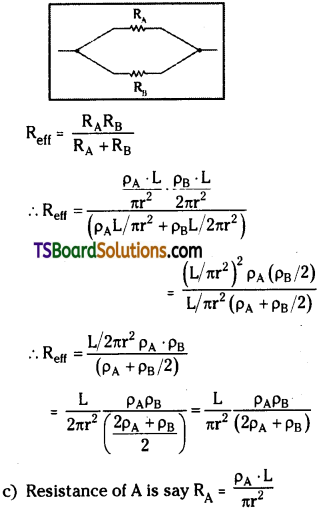
Question 3.
In a house three bulbs of 100 W each are lighted for 4 hours daily and six tube lights of 20W each are lighted for 5 hours daily and a refrigerator of 400 W is worked for 10 hours daily for a month of 30 days. Calculate the electricity bill if the cost of one unit is Rs. 4.00.
Answer:
Electric consumption in KWH per one month
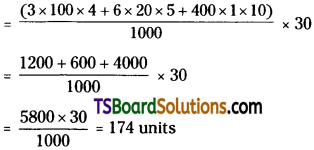
Electricity bill = No. of units × cost of unit = 174 × 4 = Rs. 696/-.
∴ Current bill, for that month is Rs. 696/-
Question 4.
Three resistors of 4 ohms, 6 ohms and 12 ohms are connected in parallel. The combination of above resistors is connected in series to a resistance of 2 ohms and then to a battery of 6 volts. Draw a circuit diagram and calculate
a) Cureent in main circuit
b) Current flowing through each of the resistors in parallel
c) P.D and the power used by the 2 ohm resistor.
Answer:
Given R1 = 4Ω, R2 = 6Ω and R3 = 12Ω
i) When R1, R2 and R3 are connected in parallel effective resistance
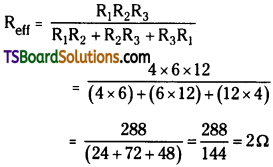
ii) Req is connected to a 2Ω resistor in series and then to a battery of 6V. The circuit diagram is as shown.
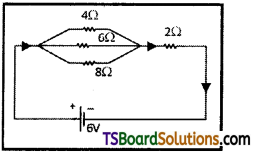
Total Resistance in circuit = Req + 2 = 2 + 2 = 4Ω
a) Current in main circuit I = \(\frac{V}{R}=\frac{6}{4}\) = 1.5 amp
b) Current through
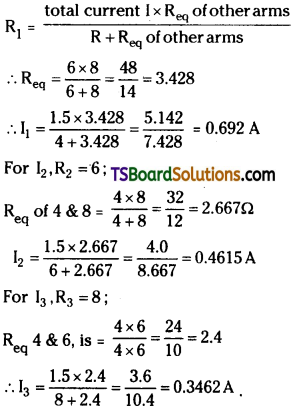
c) RD across 2Ω Resistor
i = 1.5A, R = 2Ω ∴ P.D = iR= 1.5 × 2 = 3V
Power used P = i²R = 1.5 × 1.5 × 2 = 4.5 watt.

Question 5.
Two lamps, one rated 100 W at 220 V and the other 60 W at 220 V are connected in parallel to a 220 volt supply. What current is drawn from the supply line?
Answer:
For 1st Lamp power P = 100 W at potential V = 220 V
Supply voltage V = 220 V ; Power P = VI

∴ I1 = \(\frac{100}{200}\)
For 2nd lamp power P = 60 W at 220 V.
Supply voltage = 220 V
Current i2 = \(\frac{P^2}{V}=\frac{60}{200}\)
Total current drawn by parallel combination
I = I1 + I2⇒ I = 0.4545 + 2727 = 0.7272 A
Question 6.
A light bulb is rated at 100W for a 220V supply. Find the resistance of the bulb. [IMP]
Answer:
Power P = 100 W; Potential V = 100 V

Question 7.
Estimate the average drift speed of conduction electrons in a copper wire of crosssectional area 3.0 × 10-7 m² carrying a current of 5 A. Assume that each copper atom contributes roughly one conduction electron. The density of copper is 9.0 × 10³ kg/m³ and its atomic mass is 63.5 u.
Answer:
Area A = 3.0 × 10-7m² ;
Current i = 5A
Density ρ = 9.0 × 10³ kgm-3 = 9.0 × 106gm-3
Atomic mass m = 63.5 U
Avagadro number NA = 6.022 × 1023;
Charge on electron e = 1.6 × 10-19 C
Drift velocity vd = i/neA. Where n = total number of electrons / unit volume
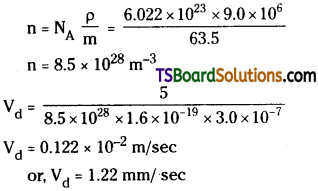
Question 8.
Compare the drift speed obtained above with
i) Thermal speed of copper atoms at ordinary temperatures.
ii) Speed of propagation of electric field along the conductor which causes the drift motion.
Answer:
Drift velocity of electrons in copper = 1.22 m.m/s
i) Thermal speed of copper atoms VT = \(\sqrt{k_{B}T/m}\).
Where kB is Boltzman’s constant.
kB = 1.381 × 10-25
Let T = 300 K average temperature or ordinary temperature
m = mass of copper atom, By subtituting the above values VT = 200 m/ sec
Vd < < Vrms
Thermal speed of copper atom is 105 times more than drift velocity of electrons.
ii) An electric field travels with velocity of light along the conductor is velocity of electromagnetic wave 3 × 108m/s.
Speed of electric field travelling along a conductor is 1011 times more than drift velocity of electrons.
Problems
Question 1.
A 10Ω thick wire is stretched so that its length becomes three times. Assuming that there is no change in its density on stretching, calculate the resistance of the stretched wire.
Solution:
Resistance R = 10Ω ; Final length l2 = 3l1
When a wire is stretched its total volume is constant.
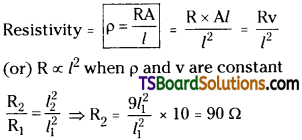
Question 2.
A wire of resistance 4R is bent in the form of a circle. What is the effective resistance between the ends of the diameter? [AP Mar. 19,14. May 16; TS Mar. 16]
Solution:
Resistance = 4R
The wire is bent in the form of a circle and Resistance is to be calculated along its diameter.

Between the point AB the wire is a parallel
combination of 2R and 2R.
∴ Resultant resistance \(\frac{1}{R_R}=\frac{1}{2R}+\frac{1}{2R}=\frac{1}{R}\)
∴ Effective resistance between A & B = R.

Question 3.
Find the resistivity of a conductor which carries a current of density of 2.5 × 106 A m-2 when an electric field of 15 Vm-1 is applied across it.
Solution:
Current density j = 2.5 × 106 A
Electric field E = 15 V m-1
Resistivity ρ = ? Resistivity p = E/j

Question 4.
What is the color code for a resistor of resistance 3500Ω with 5% tolerance?
Solution:
Resistance R = 3500 Ω. Tolerance = 5%
R = 3500 First digit 4 ⇒ Orange
2nd digit 5 ⇒ Green
Last two digits represent number of zeros = 2 ⇒ Silver
Tolerance = 5% ⇒ gold colour So colour code of that resistor is orange, green, silver and gold bands.
Question 5.
You are given 8Ω resistor. What length of wire of resistivity 120 ftm should be joined in parallel with it to get a value of 6Ω?
Solution:
Resistance Rj = 8Ω, Resistivity ρ = 12Ω m
Resistance across parallel combination Rp = 6Ω
Let parallel resistance to be connected
x = 120 / metres
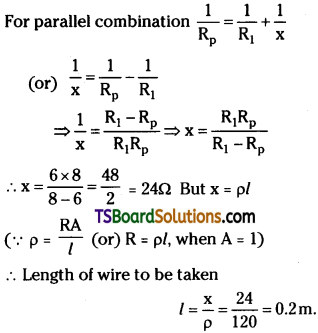
Question 6.
Three resistors 3Ω, 6Ω and 9Ω are connected to a battery. In which of them will the power dissipation be maximum if: (a) they all are connected in parallel (b) they all are connected in series? Give reasons.
Solution:
Values of resistors R1 = 3 Ω ; R2 = 6 Ω ; R3 = 9 Ω
a) When in series Reff = R1</sub. + R2 + R3 = 3 + 6 + 9 = 18
Power consumed P = \(\frac{V^2}{R}=\frac{V^2}{18}\) → (1)
b) When connected in parallel total power consumed is the sum of powers in each resistor.
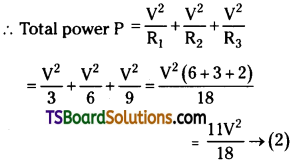
From eq 1 & 2 power dissipation is maximum when they are connected in parallel.
Question 7.
A silver wire has a resistance of 2.1Ω at 27.5°C and a resistance of 2.7Ω at 100°C. Determine the temperature coefficient of resistivity of silver.
Solution:
Temperature t1 = 27.5°C ;
Resistance R1 = 2.1 Ω
Temperature t2 = 100°C ;
Resistance R2 = 2.7 Ω
Temperature coefficient of resistivity
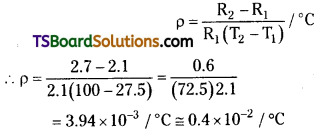
Question 8.
If the length of a wire conductor is doubled by stretching it while keeping the potential difference constant, by what factor will the drift speed of the electrons change?
Solution:
Length of wire is doubled ⇒ l2 = 2l1
Potential V = constant ; Same material is used ⇒ electron density per unit volume is same.
Drift velocity vd = \(\frac{i}{neA}\) here i, n and e are constants.
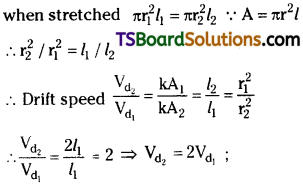
∴ Drift velocity is doubled.
Question 9.
Two 120V light bulbs, one of 25W and another of 200W are connected in series. One bulb burnt out almost instantaneously. Which one was burnt and why?
Solution:
For 1st bulb, Power P1 = 25 W; For 2nd bulb P2 = 200 W
When they are connected to mains supply of 240 V in series
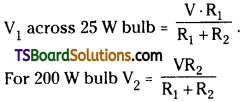
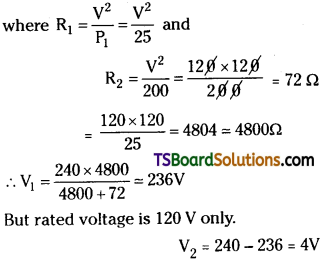
In series combination voltage drop is high on high resistance and less on low resistance.
Since voltage on 25W bulb is more than rated voltage it blows off instantly.

Question 10.
A cylindrical metallic wire is stretched to increase its length by 5%. Calculate the percentage change in resistance.
Solution:
% Increase in length = 5%
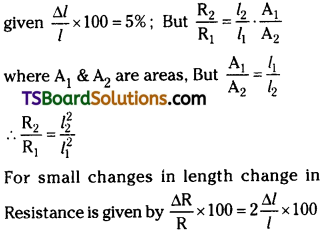
∴ Percentage change in resistance = 2 × 5 = 10%
Question 11.
Three identical resistors are connected in parallel and total resistance of the circuit is R/3. Find the value of each resistance.
Solution:
In parallel combination when ‘n’ identical wires are connected parallelly, equivalent resistance is given by Req = R/n.

Given three identical wires ⇒ n = 3.
∴ Req = R/3 where R is resistance of each wire.
∴ Resistance of each wire used in parallel combination is R.
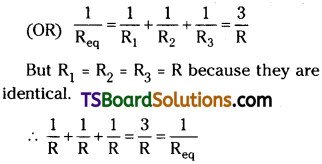
Hence resistance of each wire used in parallel combination is R.
Question 12.
Two wires A and B of same length and same material, have their cross sectional areas in the ratio 1 : 4. What would be the ratio of heat produced in these wires when the voltage across each is constant?
Solution:
Given lengths of wire are same ⇒ l1 = l2
Same material is used ⇒ ρ1 = ρ2
Ratio of area of cross sections A1 : A2 = 1 : 4 ⇒ A2 = 4A1
Potentail V is same.
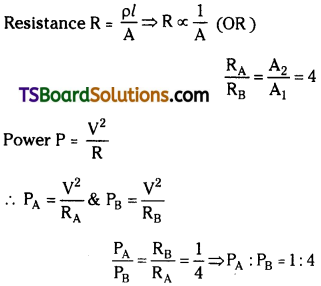
∴ Ratio of Heat produced = 1 : 4
Question 13.
Two bulbs whose resistances are in the ratio of 1 : 2 are connected in parallel to a source of constant voltage. What will be the ratio of power dissipation in these?
Solution:
Ratio of resistances ⇒ R1 : R2 = 1 : 2
⇒ R2 = 2R1
When in parallel P.D is same on each bulb.
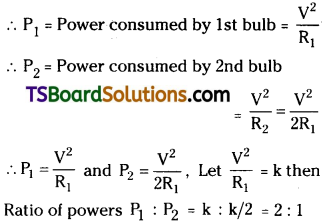
Question 14.
A potentiometer wire is 5 m long and a potential difference of 6 V is maintained between its ends. Find the emf of a cell which balances against a length of 180 cm of the potentiometer wire. [AP Mar. 17, 16. June 15; TS May 16]
Solution:
Total length of potentiometer wire L = 5 m
= 500 cm
Balancing length l1 = 180 cm
P.D across the terminals = 6V
In potentiometer e.m.f at balancing point
V = \(\frac{El}{L}\frac{6\times180}{500}\)
∴ E.m.f of cell in secondary E1 = 2.16 V

Question 15.
In a potentiometer arrangement, a cell of emf 1.25V gives a balance point at 35.0 cm length of the wire. If the cell is replaced by another cell and the balance point shifts to 63.0 cm, what is the emf of the second cell?
Solution:
Emf of the cell, E1 = 1.25 V
Balance point of the potentiometer, l1 = 35 cm
The cell is replaced by another cell of emf E2.
New balance point of the potentiometer, l2 = 63 cm.
The balance condition is given by the
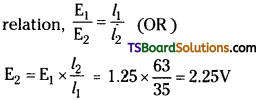
Therefore, emf of the second cell is 2.25V.
Question 16.
If the balancing point in a meter-bridge from the left is 60 cm, compare the resistances in left and right gaps of meter-bridge.
Solution:
Balancing point distance l1 = 60 cm
∴ l2 = 100 – 60 = 40 cm
Ratio of resistance \(\frac{R_1}{R_2}=\frac{l_1}{l_2}=\frac{60}{40}=\frac{3}{2}\)
(or) R1 : R2 = 3 : 2
Question 17.
A battery of emf 2.5V and internal resistance r is connected in series with a resistor of 45 ohm through an ammeter of resistance 1 ohm. The ammeter reads a current of 50 mA. Draw the circuit diagram and calculate the value of r. (Internal resistance)
Solution:
E.m.f. of battery E1 = 2.5 V ;
Internal resistance = r
Series Resistance R = 45 Ω;
Ammeter Resistance = 1Ω
Reading in ammeter = 50 mA = 50 × 10-3 Amp
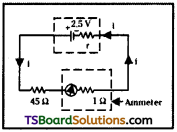
From Kirchhoff’s mesh rule
E = iR + iR1 – ir
2.5 = i 45 + i × 1 – ir
⇒ ir = 45 i + i – ir ⇒ E – 46i = – ir
∴ 2.5 – 46 × 50 × 10-3 = -50 × 10-3 r ⇒ 2.5 – 2.3 = -ir
∴ r = \(\frac{-0.2}{50\times10_{-3}}\) -ve sign indicates current in opposite direction.
∴ Internal resistance of battery
r = \(\frac{200}{50}\) = 4Ω
Question 18.
Amount of charge passing through the cross section of a wire is q(t) = at² + bt + c. Write the dimensional formula for a, b and c. If the values of a, b and c in SI unit are 6, 4, 2 respectively, find the value of current at t = 6 seconds.
Solution:
Given q (t) = at² + bt + c
But current i = \(\frac{d}{dt}\) q(t) = \(\frac{d}{dt}\) (at² + bt + c) = 2at + b → (1)
Put a = 6, b = 4, c = 2 and t = 6 in eq – (1)
∴ Current i = 2x6x6 + 4 = 72 + 4 = 76 Amp
Intext Question and Answer
Question 1.
The storage battery of a car has an emf of 12V. If the internal resistance of the battery is 0.4Ω, what is the maximum current that can be drawn from the battery?
A. Emf of the battery, E = 12 V ;
Internal resistance of the battery, r = 0.4Ω
Maximum current drawn from the battery = I ; According to Ohm’s law,
E = Ir
I = \(\frac{E}{r}=\frac{12}{0.4}\) = 30 A
The maximum current drawn from the given battery is 30 A.
Question 2.
A potentiometer wire is 5 m long and a potential difference of 6V is maintained between its ends. Find the emf of a cell which balances against a length of 180 cm of the potentiometer wire. [TS May ’16]
Answer:
Total length of potentiometer wire L = 5 m = 500 cm
Balancing length l1 = 180 cm
P.D across the terminals = 6V
In potentiometer e.m.f at balancing point
El 6×180
V = \(\frac{El}{L}=\frac{6\times180}{500}\)
∴ E.m.f of cell in secondary E1 = 2.16 V
Question 3.
A battery of emf 10 V and internal resistance 3Ω is connected to a resistor (R). If the current in the circuit is 0.5 A, what is the resistance (K) of the resistor? What is the terminal voltage of the battery when the circuit is closed? [(IMP) TS Mar, ’15]
Answer:
Emf of the battery, E = 10 V ;
Internal resistance of the battery, r = 3 Ω
Current in the circuit, 1 = 0.5 A ;Resistance of the resistor = R
The relation for current using Ohm s law is,
I = \(\frac{E}{R+r}\) ⇒ R + r = \(\frac{E}{I}\) = \(\frac{10}{0.5}\) = 20 Ω;
∴ R = 20 – 3 = 17 Ω
Terminal voltage of the resistor = V
According to Ohm’s law,
V = IR = 0.5 × 17 = 8.5 V
Therefore, the resistance of the resistor is 17 Ω and the terminal voltage is 8.5 V.

Question 6.
A negligibly small current is passed through a wire of length 15 m and uniform crosssection 6.0 × 10-7m², and its resistance is measured to be 5.0 Ω. What is the resistivity of the material at the temperature of the experiment?
Answer:
Length of the wire, l = 15 m
Area of cross-section of the wire, a = 6.0 × 10-7m²
Resistance of the material of the wire.
R = 5.0 Ω
Resistivity of the material of the wire = ρ
Resistance is related with the resistivity as
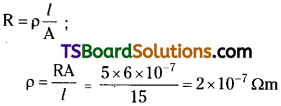
Therefore, the resistivity of the material is 2 × 10-7 Ω m.
Question 5.
A silver wire has a resistance of 2.1 Ω at 27.5 °C, and a resistance of 2.7 Ω at 100 °C. Determine the temperature coefficient of resistivity of silver.
Answer:
Temperature, T1 = 27.5°C ;
Resistance of the silver wire at T1, R1 = 2.1 Ω
Temperature, T2 = 100°C ;
Resistance of the silver wire at T2, R2 = 2.7 Ω
Temperature coefficient of silver = α
It is related with temperature and resistance as

Therefore, the temperature coefficient of silver is 0.0039°C-1.
Question 6.
Determine the current in each branch of the network shown in fig:

Answer:
Current flowing through various branches of the circuit is represented in the given figure.
I1 = Current flowing through the outer circuit
I2 = Current flowing through branch AB
I3 = Current flowing through branch AD
I2 – I4 = Current flowing through branch BC
I3 – I4 = Current flowing through branch CD
I4 = Current flowing through branch BD
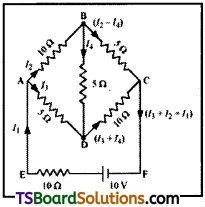
For the closed circuit ABDA, potential is zero i.e.,
10I2 + 5I4 – 5I3 = 0 (OR) ⇒ 2I2 + I4 – I3 = 0
I3 = 2I2 + I4 …… (1)
For the closed circuit BCDB, potential is zero i.e.,
5(I2 – I4) – 10(I3 + I4) – 5I4 = 0 (OR)
5I2 + 5I4 – 10I3 – 10I4 – 5I4 = 0
5I2 – 10I3 – 20I4 = 0 ; I2 = 2I3 + 4I4 ….. (2)
For the closed circuit ABCFEA, potential is zero i.e.,
– 10 + 10(I1) + 10(I2) + 5(I2 – I4) = 0
10 = 15I2 + 10I2 – 5I4 ⇒ 3I2 + 2I1 – I4 = 2 ….. (3)
From equations (1) and (2), we obtain
I3 = 2(2I3 + 4I4) + I4; I3 = 4I3 + 8I4 + I4 – 3I3 = 9I4 ⇒ -3I4 = + I3 ….. (4)
Putting equation (4) in equation (1), we obtain
I3 = 2I2 + I4 (OR) ⇒ -4I4 = 2I2 ; I2 = – 2I4 …… (5)
It is evident from the given figure that,
I1 = I3 + I2 ……. (6)
Putting equation (6) in equation (1), we obtain
3I2 +2(I3 + I2) – I4 = 2
5I2 + 2I3 – I4 = 2 ….. (7)
Putting equations (4) and (5) in equation (7), we obtain 5(-2I4) + 2(-3I4) – I4 = 2 – 10I4 – 6I4 – I4 = 2 (OR) 17I4 = – 2
⇒ I4 = \(\frac{-2}{17}\) A
Equation (4) reduces to I3 = – 3(I4) = -3\(\frac{-2}{17}=\frac{6}{17}\)A
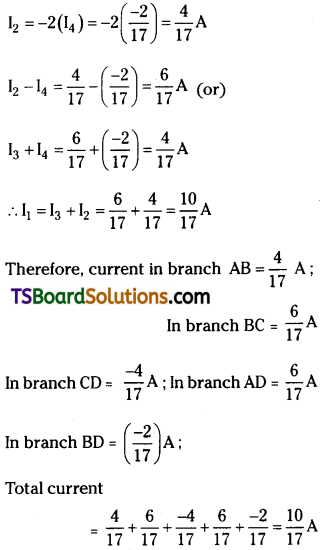
Question 7.
In a potentiometer arrangement, a cell of emf 1.25 V gives a balance point at 35.0 cm length of the wire. If the cell is replaced by another cell and the balance point shifts to 63.0 cm, what is the emf of the second cell? [(IMP) AP Mar. ’15]
Answer:
Emf of the cell, E1 = 1.25 V
Balance point of the potentiometer, l1 = 35 cm
The cells is replaced by another cell of emf E2.
New balance point of the potentiometer, l2 = 63 cm
The balance condition is given by the
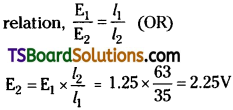
Therefore, emf of the second cell is 2.25V.

Question 8.
The number density of free electrons in a copper conductor estimated in Example 6.1 is 8.5 × 1028 m-3. How long does an electron take to drift from one end of a wire 3.0 m long to its other end? The area of cross-section of the wire is 2.0 × 10-6 m² and it is carrying a current of 3.0 A.
Answer:
Number density of free electrons in a copper conductor, n = 8.5 × 1028 m-3,
Length of the copper wire, l = 3.0 m
Area of cross-section of the wire, A = 2.0 × 10-6 m²
Current carried by the wire, I = 3.0 A, which is given by the relation,
I = nAeVd
Where, e = Electric charge =1.6 × 10-19 C
vd = Drift velocit
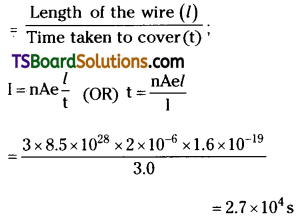
Therefore, the time taken by an electron to drift from one end of the wire to the other is 2.7 × 104 s.


![]()


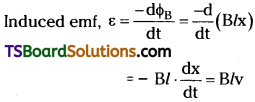
![]()
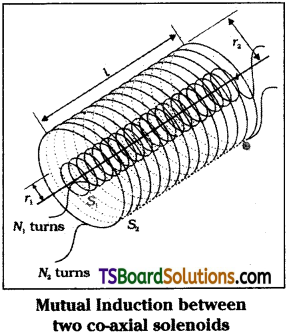
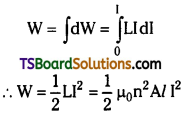
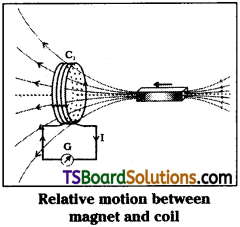
![]()
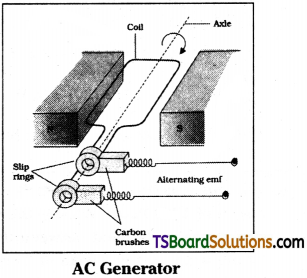
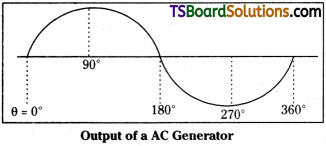




![]()

